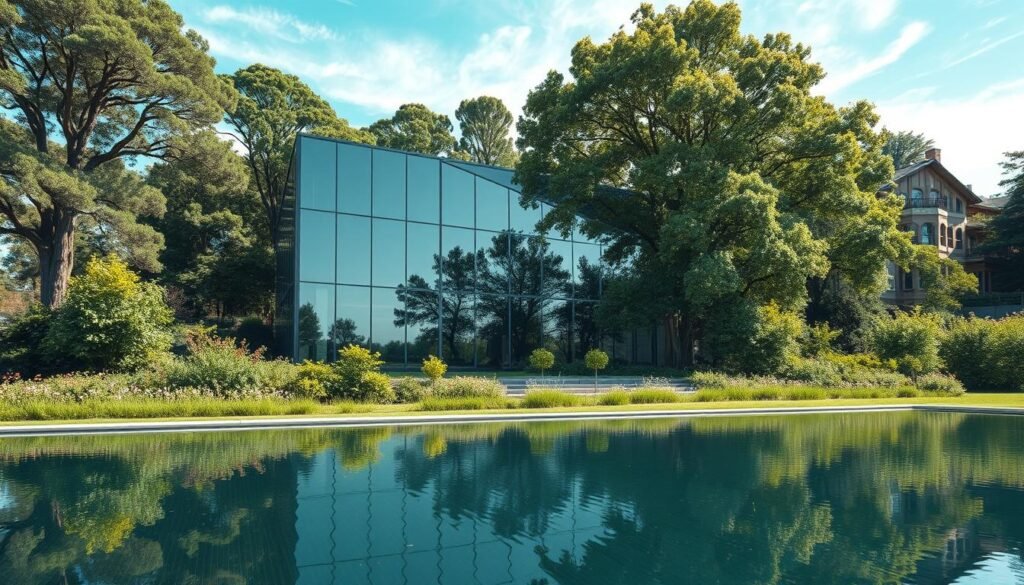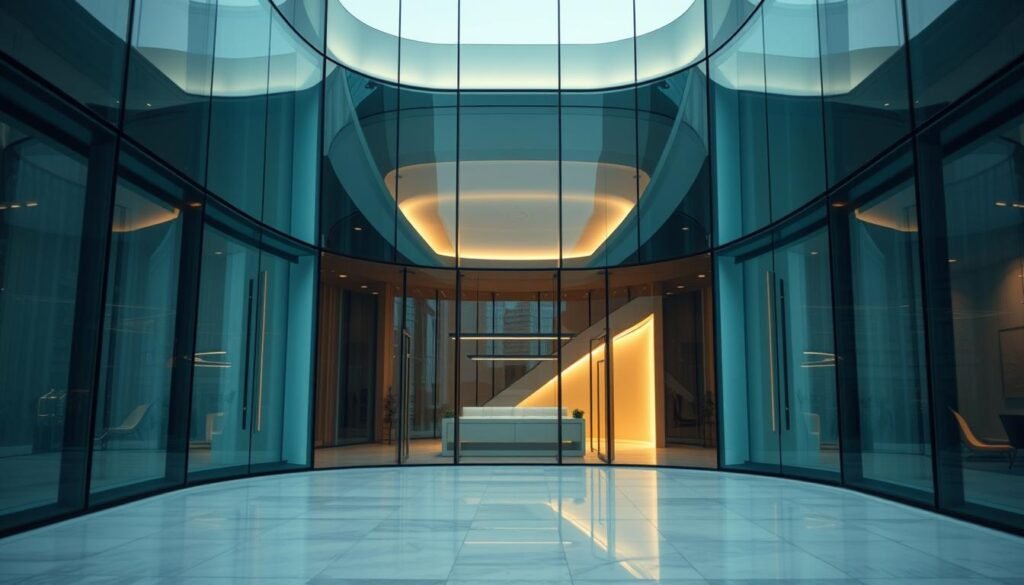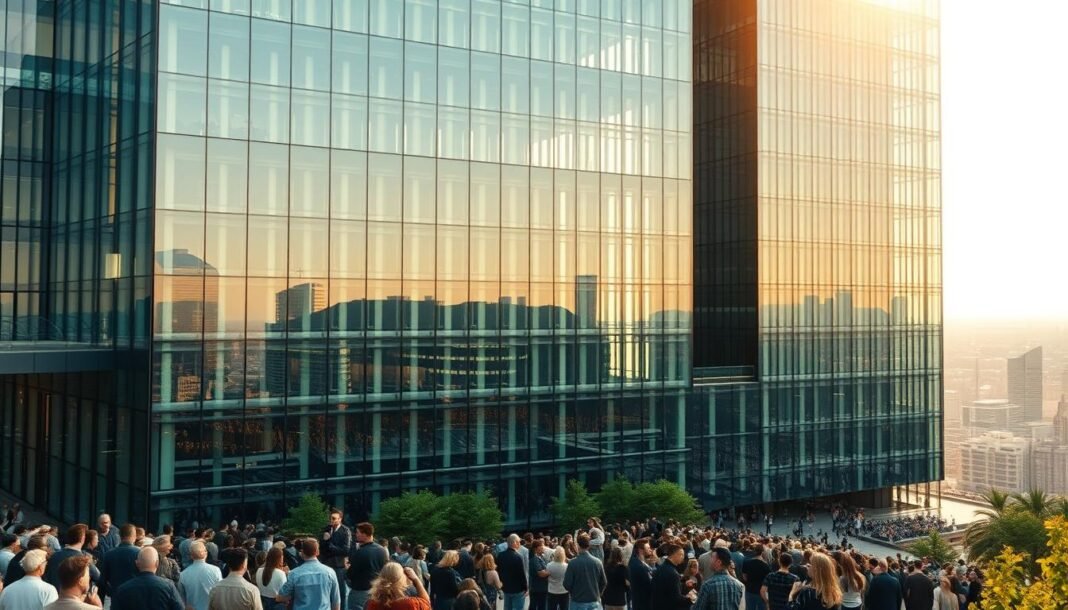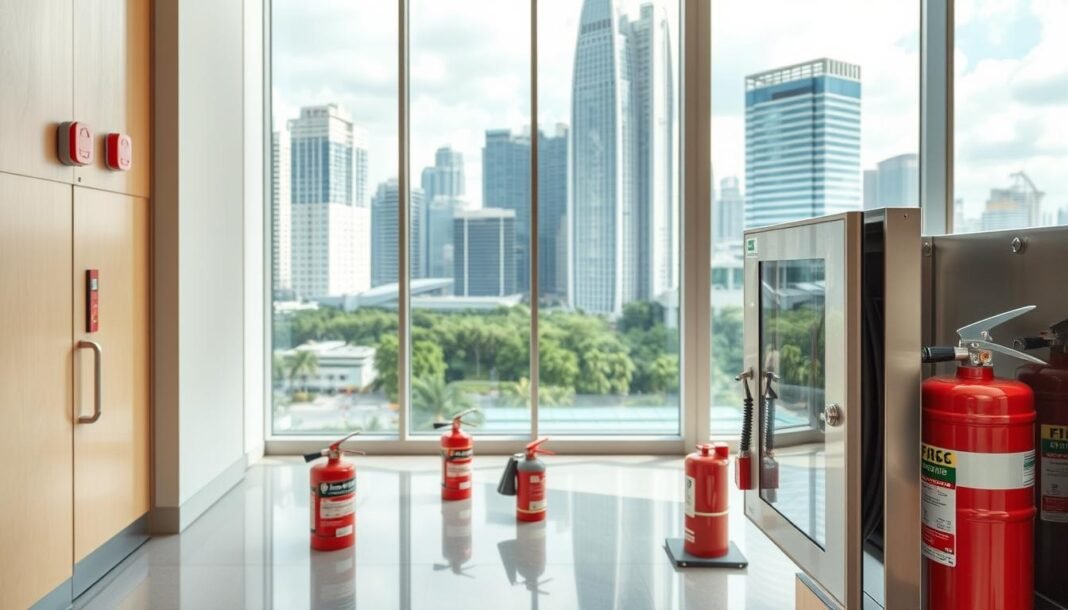Smart glass in Singapore is changing how we design buildings and homes. It uses special materials that change how much light passes through with just a button press. This glass is perfect for offices in busy city centers or modern homes, adapting to your needs.
It offers privacy, light, and style all at once. And it doesn’t lose any functionality.
Electrochromic glass combines the latest technology with beautiful design. In Singapore’s fast world, it’s a smart choice for both work and home spaces. It adjusts to your surroundings, saving energy and making your space more comfortable.
This isn’t just a new trend. It’s a smart upgrade for today’s living.
Key Takeaways
- Smart glass Singapore provides dynamic control over natural light and privacy.
- Reduces reliance on blinds or curtains for light management.
- Enhances building energy efficiency by regulating heat gain.
- Suits diverse architectural styles in Singapore’s urban landscape.
- Represents a growing market trend toward smart, adaptive design solutions.
Understanding Electrochromic Glass
Electrochromic glass is more than just a window. It’s a game-changer in modern architecture. It changes from clear to tinted with electricity, giving you control over light and privacy. This smart material has been innovating for decades, becoming key in energy efficient glass solutions.
Definition and History
Developed in the 1990s, electrochromic glass was made for energy efficient glass that changes with the environment. Companies like Clarté and Sapphire Windows worked hard to cut energy waste and improve building design. Now, it’s a common feature in Singapore’s buildings.
How It Transforms Spaces
Imagine windows that change tint with just a button. Electrochromic glass does just that. Here’s how it works:
- Light control: Tints to block glare or brightens to let in natural light.
- Privacy on demand: Switch from transparent to opaque in seconds.
- Energy savings: Reduces cooling costs by blocking heat, making it ideal as energy efficient glass.
This technology changes how spaces use light and energy. It’s a hit with architects in Singapore’s eco-conscious market.
Advantages of Electrochromic Glass Singapore
Electrochromic glass brings big changes to spaces in Singapore. It mixes modern glass design with smart tech, making spaces changeable. Just a button press changes how much light gets in, balancing privacy and light.
- Energy Savings: It cuts down on air conditioning needs, saving up to 30% on energy bills.
- Light Control: It filters sunlight to stop glare but keeps natural light in.
- Design Flexibility: Its sleek frames and adjustable tint levels fit into any modern glass design project.
“Electrochromic systems are redefining building efficiency without sacrificing aesthetics,” said a spokesperson from Singapore’s Building and Construction Authority.
It’s a game-changer for both homes and offices. Offices get better privacy controls, and homes get adjustable views. It works well in Singapore’s weather, adapting to needs. Plus, it’s easy to keep up and lasts a long time, making it a smart choice for new projects.
Design Innovations with Electrochromic Technology
Electrochromic glass is more than just useful—it’s a game-changer in design. Architects in Singapore use it to blend style with sustainability. sustainable glass systems now change how we see beauty, offering smooth shifts from clear to private. It makes spaces change without losing eco-friendly choices.

Modern Aesthetics
Picture walls that change from clear to tinted with just a touch. Electrochromic glass makes this possible with simple beauty. It fits perfectly into modern buildings like the CapitaGreen skyscraper, where glass walls adjust sunlight without needing blinds. This leads to clean lines and views that match Singapore’s focus on sustainable glass in city planning.
Customizable Options
- Tint levels: Change how much light gets through to fit any theme, from bold to soft.
- Patterned designs: Add unique patterns to the glass for branding or privacy.
- Smart integration: Connect it with voice controls or apps to match lighting and decor changes.
“Electrochromic glass isn’t just a material—it’s a canvas for rethinking space.”
Energy Efficiency and Sustainability
Electrochromic glass is a big step forward for residential glass solutions. It helps cut down on energy costs and supports green living. This smart glass changes tint levels to reduce air conditioning and artificial lighting use. This cuts down utility bills and lowers a building’s carbon footprint.
- Thermal insulation that minimizes heat transfer
- Automated solar glare control to reduce cooling demands
- Increased natural light use, decreasing electric lighting needs
| Aspect | Traditional Windows | Electrochromic Glass |
|---|---|---|
| Energy Use | High AC and lighting costs | Cuts energy use by up to 30% |
| Maintenance | Regular adjustments needed | Self-adapting to sunlight changes |
| Environmental Impact | Higher emissions | Reduces CO₂ output by optimizing light and heat |
In Singapore’s hot climate, residential glass solutions with electrochromic tech are key. They keep homes cool and green without losing style. By picking these smart windows, homeowners support Singapore’s green goals and save on energy costs over time.
Integration in Residential and Commercial Spaces
Electrochromic glass is changing how we live and work in Singapore. It makes homes and offices more flexible. Commercial glass installation experts make sure these systems look good and work well.
Home Applications
In homes, the glass makes spaces more versatile. Here are some examples:
- Private dining rooms that turn into open areas with a touch
- Windows that darken to block out too much sunlight
- Adjustable privacy in home offices for video calls
Office Environments
Offices use electrochromic glass to improve work and save energy. Commercial glass installation pros create partitions that let in light. This makes meeting rooms private and open areas comfortable all year.
“This tech lets our team focus better,” shared a manager at a Singapore fintech hub. “The glass adapts to meetings or quiet work modes effortlessly.”
Electrochromic glass shows that beauty and usefulness can meet in smart homes and offices.
Smart Control and Automation Features
Smart control systems for customizable glass options change how we use spaces. With electrochromic glass, you can change how much light gets in using apps, voice commands, or touch panels. These systems adjust based on sunlight, time, or if someone is there, making spaces change on their own.
Key features include:
- Voice-activated commands for instant privacy adjustments
- Smartphone apps for remote settings (e.g., dimming glass before meetings)
- Sensors that auto-adjust tint based on daylight
| Feature | Benefit |
|---|---|
| Automated scheduling | Pre-set routines for energy savings |
| Integration with smart homes | Syncs with lighting/AC systems for efficiency |
| Emergency override | Manual control in power outages |
Systems like SageGlass or View Dynamic Glass offer 5–10 tint levels. This fits Singapore’s climate, reducing glare and keeping views. Automation saves energy by up to 20% by using natural light better. With these customizable glass options, every space, from offices to sunrooms, can learn and change.
Installation and Maintenance Tips
Proper installation and maintenance of privacy glass technology are key for long-term use. Follow these tips to keep your electrochromic systems working well.
Professional Installation
For the best results, hire certified technicians from local experts like GlassDoc Maintenance & Services or Sapphire Windows. Here are the main steps:
- Preparation: Clean glass surfaces and frames well before starting.
- Testing: Turn on the film’s controls before installing to check it works.
- Alignment: Put electrodes in frames carefully to keep things looking good.
- Rest time: Wait 7 days after installing for the film to stick well.
Maintenance Best Practices
Keep your privacy glass technology in good shape with these care tips:
- Weekly: Dust with a dry microfiber cloth to stop debris from building up.
- Monthly: Clean with a mix of water and detergent, but avoid ammonia or rough sponges.
- Quarterly: Check edges for dirt and clean with a brush to avoid gaps.
- Annually: Get a professional to calibrate it to keep the tint right.
“Regular upkeep keeps electrochromic systems working well,” says Sapphire Windows’ tech team.
Don’t use harsh chemicals, direct heat, or let it get too wet. Store replacement parts in a dry place and always turn off power before cleaning. By doing these things, your privacy glass technology will last and look great for a long time.
Safety and Privacy Benefits
Automated glass systems do more than look good—they focus on safety. They use tempered or laminated glass, which is stronger than regular glass. This makes spaces safer in accidents or bad weather.
Instant privacy is easy to get with a touch. These systems change from clear to opaque, hiding views without losing natural light. They’re great for Singapore’s busy cities, keeping homes and offices private fast.
- Shatter-resistant cores protect against accidental breakage.
- UV-blocking layers reduce fading of indoor items while maintaining visibility.
- Discreet control via remote or sensors ensures privacy during meetings or personal moments.
| Feature | Standard Glass | Electrochromic Glass |
|---|---|---|
| Safety | Basic impact resistance | Tempered/laminated construction |
| Privacy | Requires curtains or blinds | Instant opacity adjustments |
| Maintenance | Manual adjustments needed | Automated via smart controls |
“Our automated glass systems cut privacy concerns by 90% in commercial spaces.” — SageGlass, industry leader in smart glass tech.
Opt for systems that mix style with safety. Look into View Systems’ laminated panels, which meet Singapore’s building codes and offer great control. With automated glass systems, you get both security and beauty.
Future Trends in Electrochromic Glass
The future of electrochromic glass is exciting. Intelligent glass innovation is leading to big changes. We can expect buildings to interact with their surroundings in new ways.
These changes will make spaces more eco-friendly and adaptable. The next steps will focus on smarter controls and longer-lasting materials.

Technological Advances
Scientists are exploring new materials like metal-organic frameworks (MOFs). These could make switching times faster and last longer. Imagine windows that change in seconds and last for decades.
IoT integration is also on the rise. This means glass can adjust automatically based on weather or how busy a room is. Picture windows that adjust to your preferences, saving energy and improving comfort.
Market Forecasts
- Global smart glass sales to hit $12.76 billion by 2030, growing at 9.9% annually
- Electrochromic glass alone could account for 65% of this market, fueled by energy-saving demand
- Buildings using this tech could slash cooling costs by nearly 50% and lighting expenses by over half
This technology is not just evolving; it’s becoming crucial. From Singapore’s climate to the world’s tallest buildings, it’s a game-changer. As innovation speeds up, we’ll see buildings that are as smart as they are stunning.
Comparing Electrochromic Glass to Traditional Glass
Are you deciding between electrochromic and traditional glass? Let’s explore what makes them different. Glass installation singapore experts share the main differences in performance and benefits.
- Energy Efficiency: Electrochromic glass changes tint to block heat, unlike static traditional glass. This can save up to 25% on cooling costs in Singapore’s hot climate.
- Design Flexibility: Electrochromic glass lets users adjust light and privacy instantly. Traditional glass needs curtains or shades for similar effects.
- Smart Tech Integration: Smart glass connects to home systems for automated controls. Standard glass doesn’t have this tech convenience.
- Long-Term Savings: Electrochromic glass is cheaper to maintain and use energy over time.
“Electrochromic solutions offer adaptability that traditional glass can’t match,” says industry analyst Lena Tan. “They’re reshaping how we approach glass installation singapore projects.”
While traditional glass is easier to install, electrochromic glass offers better performance. For spaces needing control over light and privacy, modern glass installation singapore teams can set up smart systems. Upgrade now and see the difference from static to smart glass solutions.
Conclusion
Electrochromic glass is changing Singapore’s buildings. Studies from Nanyang Technological University and Halio show its great performance. It cuts glare by 100%, boosts comfort by 95%, and lowers energy use by up to 25%.
Keeping EC systems in good shape is key. Clean them regularly and avoid harsh chemicals. Working with certified installers helps them last longer. In Singapore’s hot climate, smart windows are a must. They block 70% of infrared heat and let in 90% of natural light.
As cities aim for green buildings, EC glass fits right in. NTU’s new materials could make it even better. For homes or offices, electrochromic solutions are a smart choice. They make spaces adaptable and energy-efficient. Start exploring these options to make your space better today.




